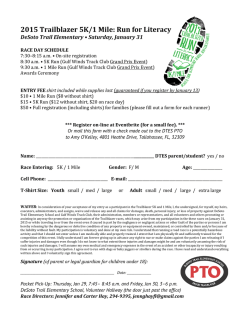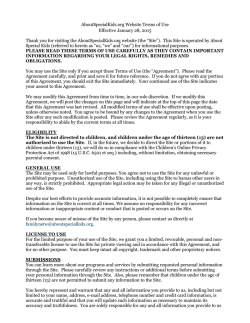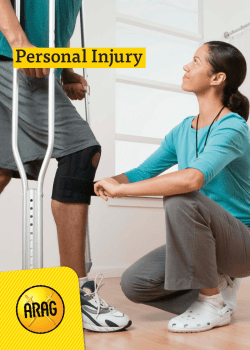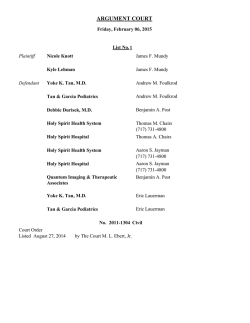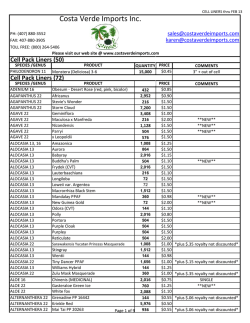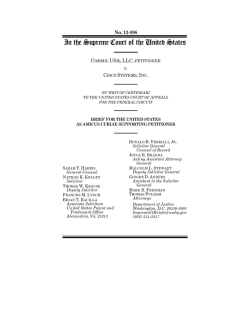
Download PDF - Gnarus Advisors LLC
Litigation Forensics Board of NACVA Complimentary Copy • Volume 1 • 2015 Practice Tips Reinterpreting the Role of the Financial Expert in the New Patent Landscape By Marc Scoppettone I n the recent past, attorneys in patent infringement litigation usually employed a single expert—typically a CPA or PhD economist—to prove their damages case. Such financial experts were generally afforded wide latitude by the courts to: • Provide broad analyses and opinions on specific industries—regardless of specific personal experience—based on the evidentiary record • Opine on consumer-buying behavior with respect to patented and non-patented features • Perform various quantitative analyses, such as regression analysis, to evaluate lost profits and price erosion claims While attorneys would sometimes propose adjunct experts from academic or industry backgrounds to buttress the damages case, the financial experts often resist the suggestion. From the point of view of the financial expert, at best, these unwanted “specialists” would need to be managed so as to not contradict or undercut the telling of the damages story. At worst, they would be viewed as interlopers who posed risks to the financial expert’s positioning as the lead consultant to the lawyers, the focal point of the damages testimony in court, and the beneficiary of the fees available in the “expert budget.” However, in recent years there has been a spate of patent infringement decisions from the Court of Appeals for the Federal Circuit (Federal Circuit) that have challenged the thoroughness and/or the expertise underlying the damages testimony. As a consequence, the old model of the “Renaissance Man” financial expert has lost favor, and the landscape for damages analysis has shifted to a coordinated, tag-team approach. Commentators and analysts have written about how landmark cases, such as LaserDynamics1 and Uniloc,2 have redefined acceptable conventions for proving damages, particularly when measured as a reasonable royalty. This article, however, presents these “new rules” cases from a different perspective—their implications as to how a financial expert should recast the damages assignment and his/her role in it, to outside counsel. These cases suggest that the financial expert now has a responsibility to assist counsel to secure all of the necessary, authoritative, evidentiary support to defend his or her assessment of patent damages. Case Study #1: Knowing the Limits of Your Expertise In Brandeis v. Keebler,3 Judge Richard Posner ruled that the plaintiff’s damages expert could not offer testimony regarding the cost of switching to a non-infringing oil blend because she was not an expert on how the change would affect consumer demand for the products—a line of Keebler cookies. Judge Posner held she should have sought reliable adjunct evidence to support her analysis. The court noted that a technical expert, who was testifying on a different topic, could have discussed the effects of using the non-infringing oil blend on the product’s taste, but the damages expert did not consult with 1 LaserDynamics, Inc. v. Quanta Computer, Inc., 694 F.3d 51, 67 (Fed. Cir. 2012). 2 Uniloc USA Inc. v. Microsoft Corp., 632 F.3d 1292 (Fed. Cir. 2011). 3 Brandeis Univ. v. Keebler Co., No. 1:12-cv-01508 (N.D. Ill. 1/18/2013) ( Doc. No. 474, at 8-10) him. The court stated that the damages expert should have consulted with a separate expert on sales or marketing in order to support the claims. Through discovery, the plaintiff may have obtained sufficient supporting evidence by requesting, through discovery, information from the defendant regarding focus group findings and taste-test analyses that incorporated quantitative analysis regarding the patented ingredient. Alternatively, the plaintiff could have commissioned its own independent survey expert to provide statistically valid evidence to support its damages expert’s analysis of non-infringing substitutes. Another option would be to conduct an econometric analysis of retail sales data, such as the Nielsen Company’s point-of-purchase scanner data. Government agencies such as the Federal Trade Commission and the Antitrust Division of the Department of Justice routinely rely on statistical analyses of retail sales data in merger analyses to determine the degree of substitutability of one product for another. It would thus seem to be a logical approach to apply in a patent damages context when the question concerns a competing non-infringing alternative. While a damages expert may not possess the skill set, anticipating the analyses needed to support the damages analysis and establishing a network of experts with required skills in other fields not only protects the damages expert from admissibility attacks but also enhances the value he or she brings to their client the process. A key lesson of this decision is not just that you must know your own limitations as a financial expert, but also that it is up to you to assist counsel address these concerns. It will more likely fall to you, the financial expert, to emphasize what you need in support of your damages opinion, from a discovery of supporting expertise viewpoint. Continued on Page 8 Page 7 Litigation Forensics Board of NACVA Complimentary Copy • Volume 1 • 2015 Continued from Page 6 Case Study #2: The Ever-Changing Royalty Base In prior years, there were few expert skirmishes over the calculation of the appropriate royalty base that resulted in Daubert exclusion. This changed at the federal district court level beginning with Cornell University v. Hewlett-Packard4 in 2010 and was ultimately affirmed at the federal circuit level in LaserDynamics: We reaffirm that in any case involving multi-component products, patentees may not calculate damages based on sales of the entire product, as opposed to the smallest salable patentpracticing unit, without showing that the demand for the entire product is attributable to the patented feature. 5 In practice, some courts have allowed exceptions to the “smallest salable practicing unit” in cases that do not meet the strict eligibility criteria for what former Federal Circuit Chief Judge Rader has renamed the “entire market value exception.” In Kimberly-Clark Worldwide, Inc. v. First Quality Baby Products, LLC,6 the court denied a motion to exclude the plaintiff’s expert’s testimony computing damages on the larger royalty base because, in keeping with Lucent v. Gateway,7 the plaintiff’s expert commensurately reduced the royalty rate she applied. (It is worth noting that it is unclear from the opinion what the alternative smallest salable unit might be.) In this case, the court noted that prior actual license agreements were structured in this manner. As if matters were not confusing enough, some federal district courts have ruled that the smallest salable unit is still too large to assess a reasonable royalty—and that the royalty base itself must be apportioned down. These opinions raise a conundrum: mathematically, the same result is reached whether one (a) reduces the smallest salable base by a given percentage before applying a royalty rate; or (b) uses the smallest salable base, then reduces the royalty rate by that percentage. Nonetheless, a court may accept one approach but not the other, requiring the damages expert to know which to use in a particular jurisdiction. In Network Protection Sciences, LLC V. Fortinet, Inc.,8 the court excluded the testimony of plaintiff’s damages expert because use of the smallest salable unit was tantamount to employing the entire market value exception without the requisite proof of a nexus with consumer demand. Similar logic resulted in expert exclusions in AVM Technologies, LLC v. Intel Corporation9, and VirnetX Inc. v Cisco Systems, Inc.10 In the latter case, the plaintiff’s expert calculated damages “from a single survey which found 70% of customers valued VoIP security. This apportionment factor is a poor substitute for the type of analysis one should undertake when parsing an alleged infringer’s profits for patents versus unpatented features.”11 The Federal Circuit later affirmed the district court’s decision in the VirnetX matter.12 With proper foresight, including recognition of the increasing level of analytical rigor that courts demand to award royalty damages, VirnetX plaintiffs could have considered several more sophisticated 4 Cornell Univ. v. Hewlett-Packard Co., 609 F. Supp. 2d 279 (N.D.N.Y. 2009). 5Supra 6 Kimberly-Clark Worldwide, Inc. v. First Quality Baby Products, LLC, No. 1:09-CV-1685 (M.D. Pa. 11/13/2013) (Doc. No. 1024) 7 Lucent Technologies, Inc. v. Gateway, Inc., 580 F.3d 1301 (Fed. Cir. 2009). 8 Network Protection Sciences, LLC v. Fortinet, Inc (N.D. Cal. 9/26/13) (Doc. No. 334, at 10-13) 9 AVM Technologies, LLC v. Intel Corp., No. 10-610-RGA (D. Del. 2/21/2013) (Doc. No. 283) 10 VirnetX Inc. v. Cisco Systems Inc., No. 6:10-CV-417 (E.D. Tex. 3/1/13) (Doc. No. 745) 11 Id. at 4. 12 Virnetx, Inc. v. Cisco Sys., Inc., No. 2013-1489, (Fed. Cir. Sept. 16, 2014). approaches. For example, plaintiff could have retained an expert in “conjoint analysis,” a special type of customer survey that ranks consumer preferences of various features, and then quantified the significance of the patented feature using a ranked logistic regression. Alternatively, plaintiff might have used data on product features and prices to perform a “hedonic regression,” which is used to parse out the value of particular attributes. Economists commonly use both of these generally accepted techniques in academic research. As such, their use in patent damages analyses, upon establishing the applicability of the underlying data, should withstand scrutiny by the courts. What is a Financial Expert to Do? Given the growing complexity in the (still evolving) legal standards to support an award of damages for patent infringement, it behooves the financial expert to meet with counsel to discuss damages strategy as early as possible. This may take persistence—patent matters differ from other types of tort cases in that, in addition to establishing liability (i.e., infringement), the plaintiff must establish that the patent is valid and enforceable. Thus, much of the legal team’s energy, on both the plaintiff and defendant side, is focused on moving the court to rule on these two key issues. Nonetheless, unless the parties have agreed, with court approval, to bifurcate the case (which stays the damages phase until liability and validity are established), it is important that the financial expert identify who will be developing the damages portion of the case and flesh out the applicable theories of damages as well as what the court will require as proof for an admissible showing of recovery under each theory. Not too long ago, the above exercise would have been sufficient to allow the financial expert to begin work in patent infringement cases. Today, however, more is needed—promptly identifying and retaining experts in complementary fields whose testimony will be invaluable in laying the analytical foundation for the damages opinions. By going through this additional strategic step early in the case, the team of experts can work together and with counsel to design a discovery plan that offers the best chance of providing evidence that can be used to directly and indirectly (through the foundational analyses and opinions) support each damages opinion expressed by the financial expert. For as the recent wave of district court and the Federal Circuit decisions have made painfully clear, the financial expert who fails to proffer rigorously supported damages testimony does so at great peril. Marc Scoppettone is a principal with Gnarus Advisors, LLC. He has more than a decade of experience consulting with attorneys, experts, and corporate clients on a range of litigation and corporate strategy matters. Mr. Scoppettone has worked with clients in a wide array of industries, including semiconductors, software, energy, utilities, pharmaceuticals, insurance, clothing and apparel, and consumer products. He specializes in applying economic and statistical methods to antitrust, intellectual property, economic damages, and class certification matters. In his litigation support practice, Mr. Scoppetone works closely with clients on every phase of the legal process, from pre-litigation analysis, discovery strategy and support, to expert reports and trial. Mr. Scoppettone holds a bachelor’s degree in economics from Stanford University and a master’s degree in statistics from Columbia University. Page 8
© Copyright 2026
